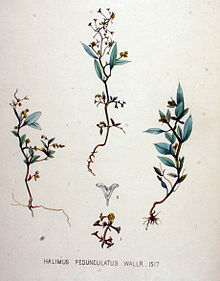Stalked Wedge
| Stalked Wedge | ||||||||||||
|---|---|---|---|---|---|---|---|---|---|---|---|---|

Stalked wedge-shaped head ( Halimione pedunculata ) |
||||||||||||
| Systematics | ||||||||||||
|
||||||||||||
| Scientific name | ||||||||||||
| Halimione pedunculata | ||||||||||||
| ( L. ) Aellen |
The stalked wedge melde ( Halimione pedunculata ), also called stem-fruited salt melde , is a species of plant in the foxtail family (Amaranthaceae). It occurs in salt plant corridors and is considered an endangered species.
description
Vegetative characteristics
The stalked Keilmelde is an annual herbaceous plant that reaches heights of between 10 and 50 centimeters. Their branching, silvery stems grow upright or ascending. The also silvery leaves are opposite in the lower part of the stem and alternately arranged in the upper part. The fleshy leaf blades are obovate to elliptical, blunt and entire, with a length of about 4 centimeters.
Inflorescence and flower
The annual inflorescences appear from July to October with inconspicuous gray-green flowers. The stalked wedge is single sexed ( monoecious ). The male flowers have no bracts , they contain four to five bracts ( tepals ) and four to five stamens . The female flowers are encased by two upwardly connected, three-lobed pre-leaves, the middle lobes of which are very short. The bracts are absent from the female flowers, they contain only one ovary .
The pollination is usually done by the wind, sometimes probably by insects.
Fruit and seed
At the time of fruiting, the stalk of the female flowers elongates so that the fruits protrude from the stem with long stems. This feature was decisive for the common German name of Gestalten Keilmelde. Characteristic of the genus Halimione is that the pericarp tightly adheres to the page forward. The seed stands upright, its root points upwards in the fruit. The seed coat is thin and membranous.
Chromosome number
The number of chromosomes is 2n = 18.
Occurrence and endangerment
The stalked wedge is native to salt plant corridors from Western Europe to Western Asia and the Black Sea. Their distribution area extends in northern Europe to southern Sweden and Estonia and in the south to Bulgaria . The main occurrence in Europe is on the coast of Denmark .
In Germany, the Gestielte Keilmelde colonizes salt marshes on the coasts of the North Sea and Baltic Sea and is also found at inland salt points . It needs full sun and nitrogen-rich, moist soil . The plant sociology calls it a characteristic of the plant society (association) Puccinellietum maritimae.
The populations of the stalked wedge have declined sharply in Europe, so that this species is now considered endangered across Europe. Due to dikes , salt marshes and marshland are no longer regularly flooded, so the disturbed areas with open ground, which are required for germination, are missing. The species has also become rare in Germany and is classified as endangered ( Red List of Endangered Species 3). The coastal deposits in Lower Saxony and Bremen are considered to be critically endangered (Red List 2), in Schleswig-Holstein as threatened with extinction (Red List 1) and in Mecklenburg-Western Pomerania even already extinct (Red List 0). In Saxony-Anhalt , where the Gestielte Keilmelde is known from some inland salt stations near Artern , Staßfurt , Hecklingen and Magdeburg , it is classified as endangered. It was found near Numburg in Thuringia , where it is considered to be threatened with extinction.
Systematics
The first publication was made of this kind in 1755 by Carl Linnaeus under the name Atriplex pedunculata L. Centuria I. Plantarum ... , 1, 34. Paul Aellen separated this way in 1938 as Halimione pedunculata (L.) Aellen of Atriplex , and set up the genus Halimione at the same time (in: Negotiations of the Natural Research Society in Basel , Volume 49, p. 124). In the following years this species was frequently returned to Atriplex . Phylogenetic studies by Kadereit et al. (2010) showed, however, that Halimione does not belong to the genus Atriplex , but rather exists as a genus of its own.
Synonyms of Halimione pedunculata (L.) Aellen are: Atriplex pedunculata L. , Chenopodium pedunculatum (L.) EHLKrause , Halimus pedunculatus (L.) Wallr. , Obione pedunculata (L.) Moq. , and Ceratocarpus maritimus Pall. ex M.Bieb. , Ceratocarpus salinus Pall. and Diotis atriplicina Spreng. .
swell
literature
- Henning Haeupler , Thomas Muer: picture atlas of the fern and flowering plants of Germany (= the fern and flowering plants of Germany. Volume 2). Published by the Federal Agency for Nature Conservation. Ulmer, Stuttgart 2000, ISBN 3-8001-3364-4 , p. 91 (section description).
- Gudrun Kadereit, Evgeny V. Mavrodiev, Elizabeth H. Zacharias & Alexander P. Sukhorukov: Molecular phylogeny of Atripliceae (Chenopodioideae, Chenopodiaceae): Implications for systematics, biogeography, flower and fruit evolution, and the origin of C4 Photosynthesis . In: American Journal of Botany , Volume 97 (10), 2010, p. 1682. (Section description, systematics)
- Stalked Wedge. In: FloraWeb.de. (Section Occurrence and Hazard)
Individual evidence
- ↑ Entry at BiolFlor
- ↑ a b Halimione pedunculata at Tropicos.org. Missouri Botanical Garden, St. Louis
- ↑ P. Uotila, 2011: Chenopodiaceae (pro parte majore) . - In: Euro + Med Plantbase - the information resource for Euro-Mediterranean plant diversity . Halimione pedunculata . Halimione pedunculata at PESI portal .
- ^ Entry in Encyclopedia of Life .
- ↑ a b Werner Rothmaler: Exkursionsflora. Volume 4, Critical Volume. Volk und Wissen, Berlin, 5th edition, 1982, p. 171.
- ↑ First description scanned at biodiversitylibrary.org
- ↑ Entry in The Plant List .
Web links
- Stalked Wedge. In: FloraWeb.de.
- Distribution of the Gestalten wedge report in Germany at FloraWeb
- Overall distribution of the stalked wedge report at Den virtuella floran
- Thomas Meyer: Data sheet with identification key and photos at Flora-de: Flora von Deutschland (old name of the website: Flowers in Swabia )
- Photos of the stalked wedge at Encyclopedia of Life
